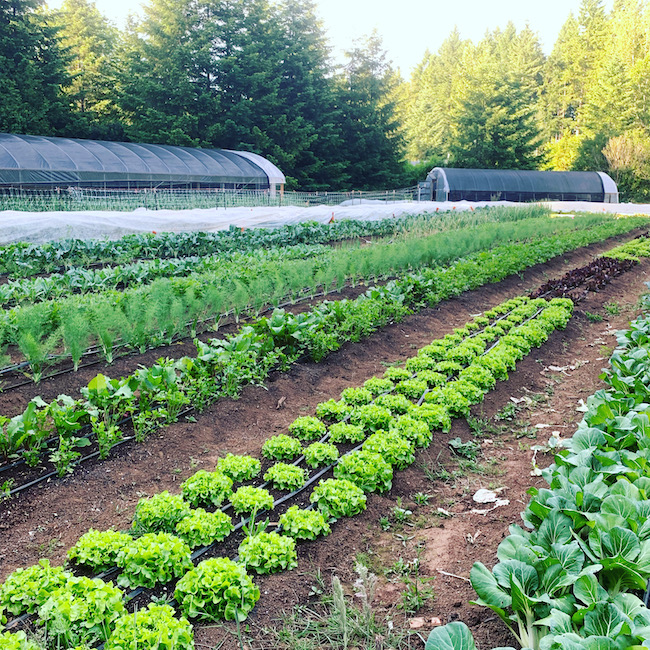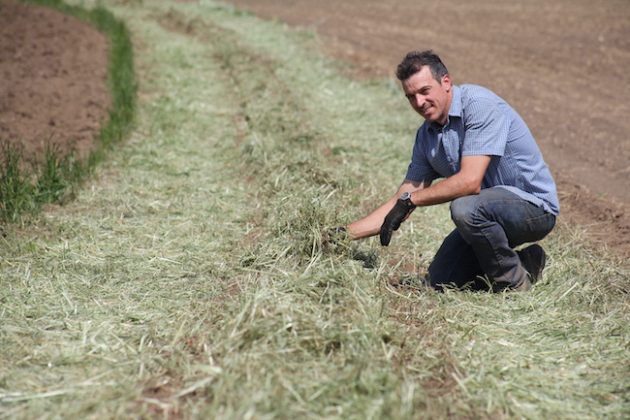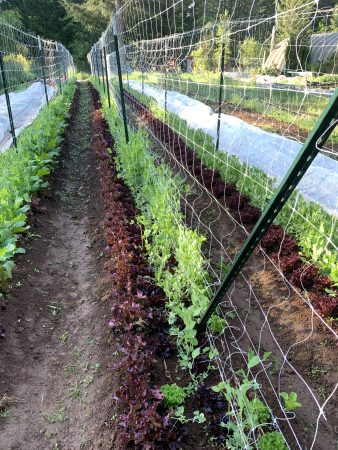
Features
Production
The benefits of leaving it be
The no-till movement is gaining ground – in more ways than one – with research behind it.
September 1, 2021 By Ronda Payne
 Blue Raven Farm in Corbett, Ore. Photo courtesy of Jen Aron.
Blue Raven Farm in Corbett, Ore. Photo courtesy of Jen Aron. The oldest photos of farmers readying their land for planting usually show some form of plowing or tilling of the soil captured in those sepia tones. Both then and now, this preparation churns the soil to bring nutrients to the seeding level and aerates the earth to make it easier for plants to spread their roots and access nutrients and water. But erosion of soils, reduction in beneficial microbes and insects, and increasing expenses for soil amendments such as fertilizers have led many farmers to consider no-till farming, which is just as old of a practice as tilling – perhaps even older.
When humans began establishing long-term dwellings, they would use a stick to create holes or very shallow furrows to drop seeds into. They were the first land cultivators and were creating a source of food at home rather than relying solely on hunting/gathering techniques.
While it’s easy to understand that no-till farming can reduce erosion, since soil is left primarily undisturbed, the debate of proven benefits and whether it’s a commercially viable solution persists within the farming community. To the conventional commercial farmer who tills, the no-till movement may seem like a fringe activity. But with positive reports from Agriculture and Agri-Food Canada (AAFC) and the U.S. Department of Agriculture, as well as events like Washington State University’s No-Till Symposium, no-till has entered the mainstream.
AAFC reports that, in 1991, farmers on the Prairies used no-till techniques on less than 10 per cent of farmland. This number grew to more than 45 per cent in 2006 and, by 2011, no-till was used on more than 55 per cent of Prairie farmland. Hardly a fringe activity at these rates.
Doug Collins, an extension specialist with Washington State University’s Center for Sustaining Agriculture and Natural Resources, is spreading the word about how no-till practices can help farmers retain soil and reduce inputs. He helped organize the 2021 No-Till Symposium and spoke at the 2021 Pacific Agriculture Show’s Horticulture Growers’ Short Course.
During his short course talk, Collins stressed that carbon stored inside the soil in small clumps – known as aggregates – stays in the ground and available to plants.
“Carbon inside of those aggregates is more or less protected,” he says. “But only if those aggregates are held together.”
Tilling breaks the aggregates apart and releases the carbon long before the seed or plant can access it.

Photo courtesy of Doug Collins.
Jen Aron, founder of Blue Raven Farm in Corbett, Ore., spoke at the symposium about her experiences with no-till. She grows enough vegetables – Brassicas, tomatoes, root crops and more – on just half an acre to feed 60 families through her community-supported agriculture program.
“There really doesn’t seem to be a one-size fits all approach to applying no-till to farms,” she says. “We utilize lots of different ways, and some things have worked and some things have not worked. But overall, the bottom line is that reducing tillage and caring for the microbes in the soil is key.”
Aron believes her farmland was logged previously but had never been cultivated. Thus, when she started out, she went through with a tractor and a plow in order to prepare the land for growing.
“We came through, ploughed and tilled and added lime. Our soil is very acidic,” Aron explains. “Certainly not great ag soil, so to speak.”
She felt that tilling was necessary in that first year to get organic matter worked in to start improving the soil quality. Aron used, and continues to use, cover crops and recommends them to maintain soil organic matter levels while using compost to increase organic matter.
The final till on the land was in 2017. Over the years, the soil has transformed and she’s learned a lot about what it needs.
“With the tiller, I noticed the soil almost looks like powdered sugar to me,” Aron says. “It just pulverized those aggregates and destroyed that soil structure. NRCS (National Resources Conservation Service) and the USDA said this about a decade ago: tilling the soil is the equivalent of an earthquake, hurricane, a tornado and a forest fire occurring simultaneously to the world of soil organisms.”
Microbes need protection because they break organic matter into nutrients and help hold aggregate structures together, thereby ensuring carbon for plants. Supporting microbes, Aron has learned, comes from reduced tilling, responsible fertilizing and planting a diverse range of crops.
Once she decided to eliminate tilling, Aron got to know which implements caused the most soil disturbance and destruction and which caused the least. Even hand tools, if used too vigorously, can cause excess damage. Tilling breaks up the upper levels of the soil but the portions below actually end up being more compacted due to the multiple passes of machinery.
“When we have areas of compaction in our soil, that’s where disease-causing organisms are going to live and thrive,” she says. “So tillage is also creating compaction zones that roots can’t penetrate.”

Photo courtesy of Jen Aron.
She dealt with challenging weeds in her first year, but as the soil improved, the weeds started to decline.
“I’m not going to lie to you. Your first year is going to be horrendous in terms of weeds, but you’ve got to just stay the course because they will, I promise, get better,” Aron says. “Start small – start with a half-acre or full acre at a time.”
There’s more to becoming a no-till farm than simply not tilling. Aron feels her approach is suitable for farms up to about four acres. Collins has been exploring various tools, like a rotating spader attachment, in larger production areas. He says it’s hard to take hand tool-based approaches and scale up.
“Contrary to popular belief, no-till can and is being accomplished on a large scale,” Aron says.
She refers to the work of individuals like Gabe Brown of Brown’s Ranch in North Dakota, who is featured in the 2020 agriculture documentary Kiss the Ground.
The no-till movement is alive and well and, through the work of Collins, Aron and others, more farmers will have the tools and information they need to make the decision of whether to till or not.
Print this page